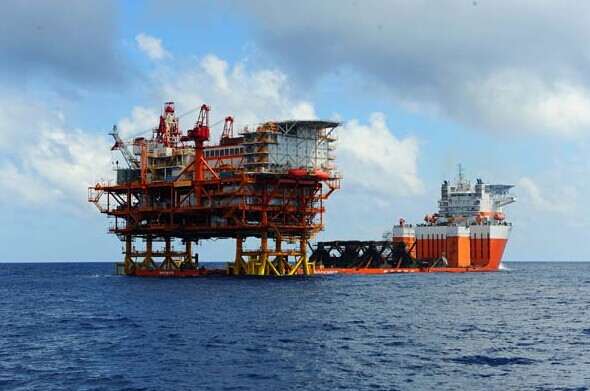

DNV GL used its advanced dynamic positioning (DP) floatover technology to support CNOOC on its first offshore platform installation in the eastern waters of the South China Sea for the Enping Oilfields. CHINA DAILY
As the company made from the merger of Norway's Det Norske Veritas and Germanischer Lloyd, the world's largest risk management company DNV GL will further broaden its China service portfolio especially in the fields of maritime, oil and gas, energy industries and management certification business over the years to come, it said in a statement.
After the merger of the two large classification societies, the new company began operations last September, providing classification and technical assurance along with software and independent expert advisory services to the maritime, oil and gas as well as energy industries.
The company also provides certification services to customers across a wide range of other industries.
Torgeir Sterri, DNV GL's vice-president, area chair and maritime regional manager for Greater China, said as China is on course to build an inclusive and sustainable industrial system, the merger-which is about growth and driving the world forward to a safer, smarter and greener future-fits well with China's overall sustainable development targets.
"With combined service categories, our customers certainly can benefit from the merger in many ways-a denser network, deepened expertise, expanded services and continuous strong commitment to research and innovation," said Sterri.
Eager to restore their earning ability, capable shipyards in China's Jiangsu and Zhejiang provinces as well as Shanghai have gradually abandoned low-end ships and moved up the value chain.
Sterri said DNV GL's commitment to China will deepen through enhanced services at a time when China is upgrading its shipbuilding industry by developing more complex ship types and offshore segments. Chinese shipyards received 40.8 million deadweight tons in new orders in the first half of 2014, up 78.2 percent year-on-year. It is still the world's top shipbuilding nation in both merchant vessels and the offshore sector, according to Beijing-based China Association of the National Shipbuilding Industry.
As current projects range from very large ore carriers to very large crude carriers, large containers, complex ship types and mobile offshore units, Sterri said DNV GL is willing to bring globally developed and accumulated expertise and experience to work with the Chinese shipyards and manufacturers together to ensure quality and safety of the vessels.
In addition, DNV GL works with the Chinese partners through joint development projects and joint industry projects to meet the challenges of today and find solutions that will benefit the industry.
One example is the cooperation of DNV GL and Shanghai Merchant Ship Design and Research Institute on the Green Dolphin bulk carrier concepts. DNV GL and SDARI used their combined and complementary expertise to deliver this green ship concept. The new design has been recognized with 100 orders placed due to its improved efficiency and environmental performance.
DNV was the first classification society in the world to introduce a rule on LNG as ship fuel in 2000. This year the milestone of 100 ships either in global operation or on order fuelled with LNG was passed. The company has classed more than 65 percent of these ships.
"LNG fueled ships are a suitable alternative to heavy-fueled ships amid rising environmental concerns, in particular in the inland waterways and coastal areas in China," Sterri said. "The new direction for the industry focuses on developing ships that use LNG."
Wang Jinlian, secretary-general of the China Association of the National Shipbuilding Industry, said from the long-term view, LNG ships will be widely used in China for multiple purposes.
"Even though higher investment cost is a challenge for the LNG option, this is more than offset by fuel-saving costs over the life cycle of a ship," Wang said. "China should strengthen LNG tank construction at import terminals for further distribution and adopt small LNG carriers for short sailing distances."
As deep-water fields are important to China's energy future, DNV was also one of the earliest involved in China's offshore development back in the 1980s. Most of the harsh and deep-water offshore units contracted to China shipyards are sent to DNV GL class.
DNV GL currently carries out a number of ongoing offshore projects in China's main offshore shipyards. Through these projects, the company assists the yards to improve their technical understanding, production systems, health safety and environment systems, which help them start to close the gap with their international rivals.
The company's experts are also supporting China's largest offshore oil and gas company-China National Offshore Oil Co-on its first offshore platform installation in China using advanced dynamic positioning
This year marks DNV's 150th anniversary and the first-year anniversary of the merged company, Sterri said the company will continue its commitment to China. One aspect that DNV GL can contribute is training as the company has accumulated vast experience and expertise in the maritime and offshore industry. To impart the knowledge, DNV GL established an academy in 2005 to meet increasing demand for competence development in China's maritime industry.
The DNV GL academy offers a wide range of training courses in the maritime industry including offshore rules, regulations, classification, operation, new-building design, safety management, security and risk management courses.
Thousands of maritime professionals in China have been trained through the DNV GL Academy network including at its branches in Dalian, Shanghai, Nantong, Guangzhou, Hong Kong, Taipei and Kaohsiung.
Copyright ©1999-2018
Chinanews.com. All rights reserved.
Reproduction in whole or in part without permission is prohibited.